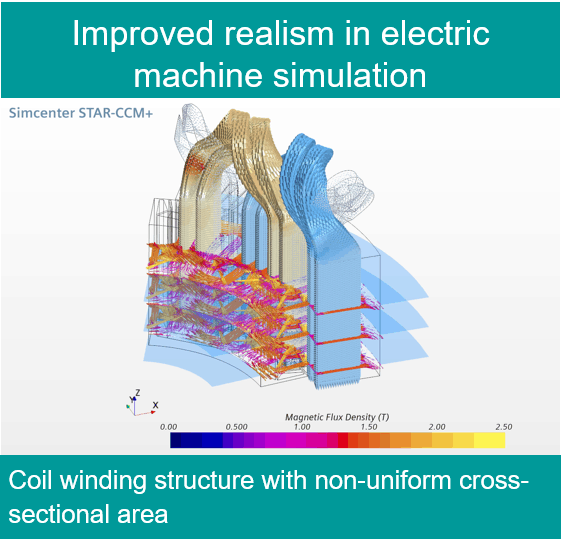STAR-CCM+
This week, we will look at the news that are left from the 2020.3 release of Simcenter STAR-CCM+. We know that we have reached the year 2021 now, but there are still some interesting updates not previously mentioned in the Volupe blog. The focus this time will be mainly the topics not handled in previous posts.
Finite Element Excitation Coil model- Boundary Method
Excitation coils are one of the two common methods (magnets are the other one) to create a magnetic field. In stranded excitation coils, thin wires conduct a time-dependent current, which in turn produces a magnetic field. Since the electric current skin-depth is large compared to the small thickness of the wires, eddy currents can be neglected, and the resulting electric current density is almost uniformly distributed across the cross-section.
With the FE Excitation Coil model users can model excitation coils with complex winding geometries. The user can impose the total electric current flowing in the coil as a boundary condition [so-called Boundary Method]. The electric current density distribution computed by the solver is divergence-free by design, which allows for (1) smoother magnetic vector potential distributions and (2) a faster convergence with the FE iterative solver. Previous versions of the Excitation Coil model were limited to FV only. To setup an FE coil, one needed a less intuitive workaround, potentially resulting in non-divergence-free currents with detrimental effects on convergence and accuracy. Moreover, only windings with uniform cross-section could be modeled in a user-friendly way.

Demagnitization Indication model
The demagnetization curve of a permanent magnet consists of two nearly linear parts. These two regimes are separated by a small curvature region called “knee point”. This knee point represents a critical value separating the reversible from the irreversible demagnetization regimes.
If a magnet is reversibly demagnetized, then it would return to its original magnetization when the demagnetization field is switched off. The threshold value is temperature-dependent, as implemented in this new model. Demagnetization is detrimental in applications where the magnets’ strength must stay constant. This model is beneficial for e-machines, where it is desirable that the motor torque performance do not decrease. The animation below shows an oscillation permanent magnet in the magnetic field induced by a coil, quarter model. Visualization of Demagnetization Flux Density, highlighting areas of the magnet at risk of irreversible demagnetization.
Finite Element Direct Solver in frequency domain
Previously, Simcenter STAR-CCM+’s Harmonic Balance EMAG offering was limited to FV only. Consequently, one could simulate only applications where the magnetic permeability did not experience large jumps at interfaces: diamagnetic or paramagnetic materials. With this new model, one can simulate cases with (linearized) ferromagnetic materials too. So far, only dia-/paramagnetic materials could be simulated in frequency domain. This is as mentioned a direct solver, but worth mentioning is that an iterative version is under development.
The animation below shows an induction heating simulation where the EMAG fields where computed with the new FE harmonic balance solver.
Adaptive Mesh refinement (AMR) wider physics coverage
Additional compatibilities for Adaptive Mesh Refinement (AMR). AMR is not driven by those models but rather by user defined or other inbuilt models. For example for Gas turbines the combustion driven AMR we use the combustion AMR model.
Application multi-component liquid reaction with 2 competing reactions, where micro-mixing effects are important. Without AMR you see some pulsation where the reactant (NaOH) is injected of the slow forming product. This is because in the larger cells the reactant is consumed by the competing faster reaction. With AMR refinement, this is no longer the case, which is more realistic. This can be seen in the animation below.
I hope this has been useful. At this point we are all looking forward to the version 2021.1 coming in February. As usual, do not hesitate to reach out at support@volupe.com.
Also read
How to use filter and queries in Simcenter STAR-CCM+
Rotating Flow Part 2
Simcenter STAR-CCM+ version 2020.3 news – Part 2
Simcenter STAR-CCM+ version 2020.3 news – Part 1
How to run a basic simulation in Simcenter FloEFD
Release update on Simcenter STAR-CCM+ 2020.2 part 2




